1Clinical Laboratory Science, College of Applied Medical Science-Qurayyat, Jouf University, Qurayyat, Saudi Arabia.
2Clinical Laboratory Science, College of Applied Medical Science-Sakaka, Jouf University, Aljouf, Saudi Arabia.
3Clinical Laboratory Science, College of Applied Medical Science-Sakaka, Jouf University, Aljouf, Saudi Arabia.
4Clinical Laboratory Science, College of Applied Medical Science-Sakaka, Jouf University, Aljouf, Saudi Arabia.
5College of Medicine, University of Ḥaʼil, Ḥaʼil, Saudi Arabia.
6Department of Internal Medicine, Al Imam Mohammad Ibn Saud Islamic University (IMSIU), Riyadh, Saudi Arabia.
7King Salman Hospital, Hail, Saudi Arabia.
8College of Medicine, University of Ḥaʼil, Ḥaʼil, Saudi Arabia.
9Department of Pathology, College of Medicine, University of Kratom CITY ???
Crresponding author email: elasbaliuoh@gmail.com
Article Publishing History
Received: 19/03/2021
Accepted After Revision: 29/05/2021
Stomach cancer is the second leading cause of cancer-related mortality worldwide. The present study aimed to answer whether Helicobacter pylori associated is suspicious of gastric cancer as a cause for gastric biopsy over-diagnosis. In this descriptive retrospective study, we retrieved data referring to gastric biopsies for one year back from the Department of Pathology at King Salman Hospital, Hai’l, Northern Saudi Arabia. The study included data referring to gastric biopsies patients diagnosed during the period from October 2019 to November 2020. The most identified histopathological finding was chronic inflammation 179/192(93.2%) included 84/88(95.5%) males and 95/104(91.3%) females. Acute inflammation was identified in 6/192(3%) patients, included 2/88(2.3%) males and 4/104(3.8%) females. Benign lesions were diagnosed in 3/192(1.6%) cases, 1/88(1.13%) male and 2/104(1.92%) females. Carcinoma of the stomach was diagnosed in 3/192(1.6%) patients, included 1/88(1.13%) male and 2/104(1.92%). Females. There is an overuse of gastric endoscopic diagnosis. H. pylori infection is prevalent in Northern Saudi Arabia. It frequently makes confusion for gastric carcinoma. The incidence of gastric cancer and other benign stomach tumors is very low in Northern Saudi Arabia. Strict guidelines for gastric endoscopy is deemed necessary in Northern Saudi Arabia.
Stomach Cancer, Gastric Cancer, H. Pylori, Saudi Arabia, Gastric Biopsy, Endoscopy
Elasbali A.M, Mohammed S.A, Omer A.M, Shalabi M.G, Alrashid F.F, Alharbi S.H, Alanazi K.K, Ahmed J.H. Is Helicobacter pylori Association Suspicious of Gastric Cancer ? A Descriptive Retrospective Study. Biosc.Biotech.Res.Comm. 2021;14(2).
Elasbali A. M, Mohammed S. A, Omer A. M, Shalabi M. G, Alrashid F. F, Alharbi S. H, Alanazi K. K, Ahmed J. H. Is Helicobacter pylori Association Suspicious of Gastric Cancer ? A Descriptive Retrospective Study. Biosc.Biotech.Res.Comm. 2021;14(2). Available from: <a href=”https://bit.ly/3gPwJqU“>https://bit.ly/3gPwJqU</a>
Copyright © Elasbali et al., This is an open access article distributed under the terms of the Creative Commons Attribution License (CC-BY) https://creativecommns.org/licenses/by/4.0/, which permits unrestricted use distribution and reproduction in any medium, provide the original author and source are credited.
INTRODUCTION
Gastric carcinoma is the second leading cause of cancer-related mortality worldwide. However, the epidemiology has been changed in the past few years due to increased awareness toward gastric cancer risk factors (Sitarz et al., 2018). Notably, gastric cancer’s geographical epidemiology had changed in recent years with progressive eradication of Helicobacter pylori (H. pylori) and improved hygiene (Fock, 2014; Marghalani et al., 2020). Many risk factors have been implicated in stomach cancer’s etiology, such as H. pylori, tobacco smoking, alcohol consumption, obesity/overweight, and eating red meat, etc. (Poorolajal et al., 2020a; Poorolajal et a. 2020b). However, H. pylori infection represents the primary cause of gastric cancer (Holleczek et al., 2020), usually associated with chronic gastritis (Chen et al., 2020).
The available literature from Saudi Arabia reported an incidence of 2.7% of gastric cancer in 2013 (Abuderman, 2019); however, later report has shown that gastric cancer increased 3-fold (Althubiti and Nour Eldein, 2018). A study from Saudi Arabia has reported a prevalence of 58.1% for H. pylori infection, which is relatively higher than the global reports (Akeel et al., 2018).Several laboratory tests exist to diagnose H. pylori infection (Nakamura, 2001) other than the invasive endoscopic biopsy. However, overdiagnosis of gastric tumors may be encountered with H. pylori infection. Therefore, the present study aimed to answer whether H. Pylori-associated suspicious of gastric cancer a cause for gastric biopsy over-diagnosis.
MATERIAL AND METHODS
In this descriptive retrospective study, we retrieved data referring to gastric biopsies for one year back from the Department of Pathology at King Salman Hospital, Hai’l, Northern Saudi Arabia. The study included data referring to gastric biopsies patients who were diagnosed during the period from October 2019 to November 2020. The diagnosis of gastric tissue biopsies was confirmed by conventional histopathology. The re-evaluation of the histopathological diagnosis of the tissue samples was completed to verify the prior diagnosis and categorize the lesion’s classification into benign and malignant types or other varieties.
Statistical analysis: Data were analyzed using computer software; Statistical Package for Social Sciences (SPSS version 16; SPSS Inc, Chicago, IL). Chi squire test was employed to statistical significance (P < 0.05 was considered significant).
Ethical consent: The protocol of this study was established agreeing with the 2013 Declaration of Helsinki. Additionally, the study’s protocol was approved by the ethics committee of the College of Medicine, University of Hail, Saudi Arabia. Ethical Committee approval number: EC00069.
RESULTS AND DISCUSSION
This study investigated 192 patients denoted for gastric biopsy, 88(45.8%) were males, and 104(54.2%) were females. Their ages ranged between 14 to 84 years, with a mean age of 38 years. Most patients were aged < 25 years & 25-34 years, constituting 45/192(23.4%) each, followed by 35-44 years and 45-54 years representing 39/192(20.3%), and 32/192(17.7%), respectively. Most males were at age range < 25 years 21/88(23.9%); hence, most females were at the age group 25-34 years 25/104(24%), as indicated in Table 1, Fig 1.
Table 1. Distribution of the study subjects by sex and age
| Age | Males | Females | Total |
| <25 years | 21 | 24 | 45 |
| 25-34 | 20 | 25 | 45 |
| 35-44 | 20 | 19 | 39 |
| 45-54 | 11 | 21 | 32 |
| 55-64 | 11 | 12 | 23 |
| 65+ | 5 | 3 | 8 |
| Total | 88 | 104 | 192 |
Figure 1: Description of the study subjects by age and sex
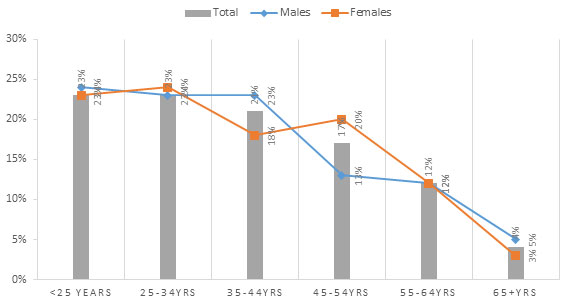
The most identified histopathological finding was chronic inflammation 179/192(93.2%) included 84/88(95.5%) males and 95/104(91.3%) females. Acute inflammation was identified in 6/192(3%) patients, included 2/88(2.3%) males and 4/104(3.8%) females. Benign lesions were diagnosed in 3/192(1.6%) cases, 1/88(1.13%) male and 2/104(1.92%) females. Carcinoma of the stomach was diagnosed in 3/192(1.6%) patients, included 1/88(1.13%) male and 2/104(1.92%). Females, as indicated in Table 2, Fig 2, as shown in Image 1.
pylori infection was diagnosed in 122/192(63.5%), included 55/88(62.5%) males and 67/104(64.4%) females. The relative risk (RR) of association between H. pylori infection and females sex, and the 95% confidence interval (95%CI); RR (9%CI) =1.0308 (0.8307 to 1.2791), P = 0.7832, z statistics = 0.275, shown in Table 2, Fig 2.
Table 2. Distribution of the study subjects by sex and histopathological diagnosis
| Diagnosis | Males | Females | Total |
| Histopathology | |||
| Acute inflammation | 2 | 4 | 6 |
| Chronic inflammation | 84 | 95 | 179 |
| Benign lesion | 1 | 2 | 3 |
| Gastric Carcinoma | 1 | 2 | 1 |
| Total | 88 | 104 | 192 |
| H. pylori | |||
| Positive | 55 | 67 | 122 |
| Negative | 33 | 37 | 70 |
| Total | 88 | 104 | 192 |
Figure 2: The study subjects by sex and histopathological diagnosis
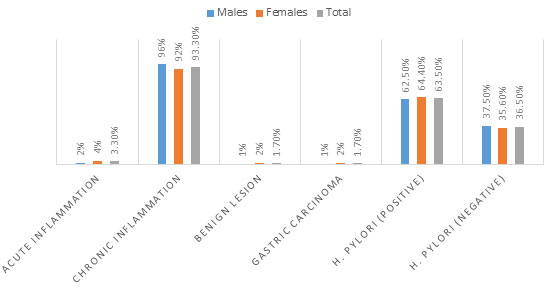
Image 1.
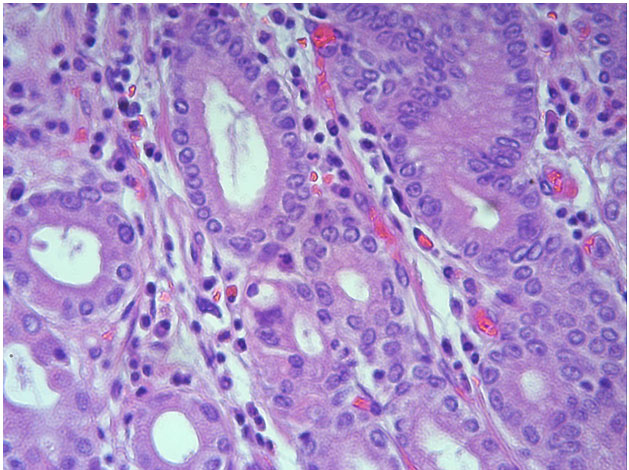
Microphotographic 1. Gastric Carcinoma (H&E) x400
Table 3, Fig 3, summarized the distribution of the study subjects by sex and histopathological diagnosis. Chronic inflammation was more frequent among the younger population <44 years. Acute inflammation was common between 35 to 54 years. Benign lesions were observed between 35 years and 64 years. Gastric carcinoma was distributed in younger age, middle age, and older age. Positive H. pylori were more frequent in the younger age ranges. However, when calculating the percentages within each age group, variable proportions can be observed, as shown in Fig 3 and Image2.
Table 3. Distribution of the study subjects by age and histopathological diagnosis
| Diagnosis | <25years | 25-34 | 35-44 | 45-54 | 55-64 | 65+ | Total |
| Histopathology | |||||||
| Acute inflammation | 2 | 0 | 2 | 2 | 0 | 0 | 6 |
| Chronic inflammation | 43 | 44 | 36 | 28 | 21 | 7 | 181 |
| Benign lesions | 0 | 0 | 1 | 1 | 1 | 0 | 3 |
| Gastric Carcinoma | 0 | 1 | 0 | 1 | 0 | 1 | 2 |
| Total | 45 | 45 | 39 | 32 | 23 | 8 | 192 |
| H. Pylori | |||||||
| Positive | 27 | 28 | 23 | 24 | 15 | 5 | 122 |
| Negative | 18 | 17 | 16 | 8 | 8 | 3 | 70 |
| Total | 45 | 45 | 39 | 32 | 23 | 8 | 192 |
Figure 3: The proportions of the study subjects by age and histopathological diagnosis within the entire age group
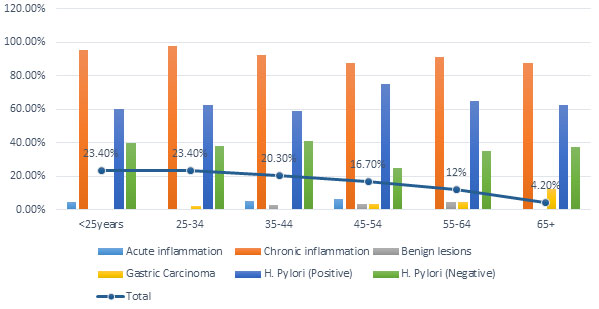
Image 2.
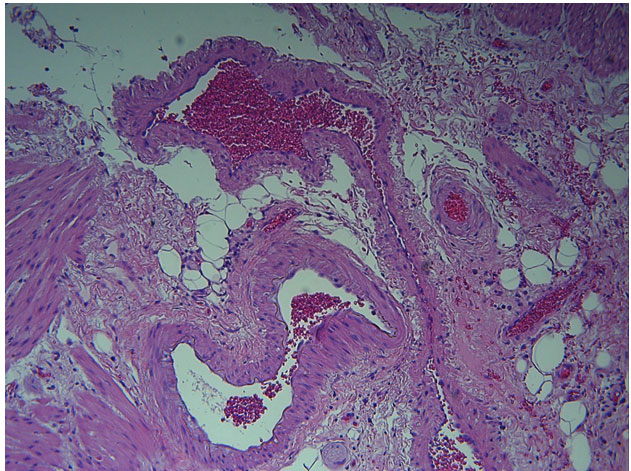
Microphotographic 1. Gastric Carcinoma (H&E) x100
As cancer is growing to be a concern for many people, and with a greasing level of awareness programs in addition to widespread of cancer early detection tests, the number of over-diagnosis is increasing with the application of invasive diagnostic methods. With the increased prevalence of H. pylori infection, several patients with the infection are subjected to gastric endoscopic biopsies. In the present study, the incidence of gastric cancer was 1.5%, and the incidence of benign conditions was 1.5%. The remaining 97% biopsies were performed for inflammatory diseases, some of which were associated with H. pylori infection. This incidence of gastric cancer was much lower than the previously reported incidence of 2.7% (Abuderman, 2019).
The incidence of H. pylori infection in the current study was 63.5%. This incidence may predict a high prevalence rate in the country. H. pylori infection is the primary cause of chronic active gastritis, peptic ulcer, and gastric cancer. H. pylori infect around 50% of the world population, making it the most widespread infection worldwide (Akeel et al., 2018). Studies from Saudi Arabia report high prevalence rates of H. pylori infection. A study from Saudi Arabia reported H. pylori infection 67-87% of the children diagnosed with peptic ulcer (El Mouzan and Abdullah, 2004).
Another study from Saudi Arabia investigated school children with chronic recurrent abdominal pain; 73% were detected as positive for H. pylori infection, including 62.9% and 82.1% positive infection in an intermediate and secondary school in that order (Telmesani, 2020). Another study from Saudi Arabia has found a relatively lower prevalence of H. pylori infection, 49.8% in the investigation included 303 children (Hasosah, 2019). In a random analysis of 3551 healthy children, seropositive for H. pylori infection was detected in 40% (Al-Hussaini et al., 2019).
pylori infection and other gastric problems were more apparent among females. With the lack of evidence showing the close association between H. pylori infection and female gender, the relationship between female sex and increased risk of gastric cancer has been documented (Choi and Kim, 2016).The association between gastric conditions mentioned in the current study did not show any significant indications, and similarly, the connection with H. pylori infection. Although the present study has some limitations, including its retrospective setting, it provides valuable guidance for physicians and health managers for suitable guidelines for more accurate management of patients selected for gastric endoscopy.
CONCLUSION
There is an overuse of gastric endoscopic diagnosis. H. pylori infection is prevalent in Northern Saudi Arabia and frequently creates confusion for gastric carcinoma. The incidence of gastric cancer and other benign stomach tumors is very low in Northern Saudi Arabia. Implementing strict guidelines for gastric endoscopy is deemed necessary in Northern Saudi Arabia.
ACKNOWLEDGEMENT
The authors extend their appreciation to the Deputyship for Research & Innovation, Ministry of Education in Saudi Arabia for funding this work through the grant number “1172659343”The authors would like to extend their sincere appreciation to the central laboratory at Jouf University for support this study.
REFERENCES
Abuderman AA. (2019) Gastric cancer and prospects of cancer in Saudi Arabia peninsula. Saudi Journal of Biological Sciences 26(6):1095-1100.
Akeel M, Elmakki E, Shehata A,(2018) Prevalence and factors associated with H. pylori infection in Saudi patients with dyspepsia. Electron Physician. 10(9):7279-7286.
Al-Hussaini AA, Al Jurayyan AN, Bashir SM, Alshahrani D.(2019) Where are we today with Helicobacter pylori infection among healthy children in Saudi Arabia? Saudi J Gastroenterol. Sep-Oct;25(5):309-318.
Althubiti MA, Nour Eldein MM.(2018) Trends in the incidence and mortality of cancer in Saudi Arabia. Saudi Med J. 39(12):1259-1262.
Chen QF, Zhou XD, Fang DH, Zhang EG, Lin CJ, Feng XZ, Wang N, Wu JS, Wang D, Lin WH.(2020) Helicobacter pylori infection with atrophic gastritis: An independent risk factor for colorectal adenomas. World J Gastroenterol. Oct 7;26(37):5682-5692.
El Mouzan MI, Abdullah AM.(2004) Peptic ulcer disease in children and adolescents. J Trop Pediatr 50:328-30.
Fock KM.(2014) Review article: the epidemiology and prevention of gastric cancer. Aliment Pharmacol Ther. Aug;40(3):250-60.
Hasosah M. (2019) Accuracy of invasive and noninvasive methods of Helicobacter pylori infection diagnosis in Saudi children. Saudi J Gastroenterol. Mar-Apr;25(2):126-131.
Holleczek B, Schöttker B, Brenner H. (2020) Helicobacter pylori infection, chronic atrophic gastritis and risk of stomach and esophagus cancer: Results from the prospective population-based ESTHER cohort study. Int J Cancer May 15;146(10):2773-2783.
Marghalani AM, Bin Salman TO, Faqeeh FJ, Asiri MK, Kabel AM.(2020) Gastric carcinoma: Insights into risk factors, methods of diagnosis, possible lines of management, and the role of primary care J Family Med Prim Care Jun 30;9(6):2659-2663.
Nakamura RM. (2001) Laboratory tests for the evaluation of Helicobacter pylori infections. J Clin Lab Anal. 15(6):301-7.
Poorolajal J, Moradi L, Mohammadi Y, Cheraghi Z, Gohari-Ensaf F. (2020 a) Risk factors for stomach cancer: a systematic review and meta-analysis. Epidemiol Health. 42:e2020004.
Poorolajal J, Sahraei F, Mohamdadi Y, Doosti-Irani A, Moradi L.(2020 b) Behavioral factors influencing childhood obesity: a systematic review and meta-analysis. Obes Res Clin Pract. Mar-Apr;14(2):109-118.
Sitarz R, Skierucha M, Mielko J, Offerhaus GJA, Maciejewski R, Polkowski WP.(2018) Gastric cancer: epidemiology, prevention, classification, and treatment. Cancer Manag Res. Feb 7;10:239-248.
Telmesani AM ( 2009) . Helicobacter pylori: Prevalence and relationship with abdominal pain in school children in Makkah city, western Saudi Arabia. Saudi J Gastroenterol [serial online] [cited 2020 Dec 3;15:100-3. Available from: https://www.saudijgastro.com/text.asp?2009/15/2/100/45359


